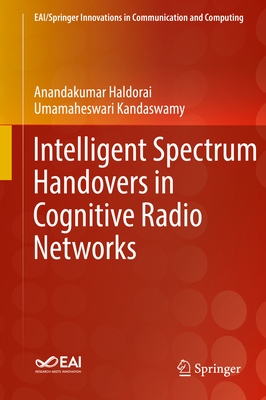Cognitive Radio Networks: Efficient Resource Allocation in Cooperative Sensing, Cellular Communications, High-Speed Vehicles, and Smart Grid Hardcover
暫譯: 認知無線電網路:在合作感知、行動通訊、高速車輛及智慧電網中的有效資源配置 精裝版
Tao Jiang, Zhiqiang Wang, Yang Cao
- 出版商: CRC
- 出版日期: 2015-04-08
- 售價: $4,500
- 貴賓價: 9.5 折 $4,275
- 語言: 英文
- 頁數: 148
- 裝訂: Hardcover
- ISBN: 1498721133
- ISBN-13: 9781498721134
-
相關分類:
Wireless-networks
立即出貨 (庫存=1)
相關主題
商品描述
Resource allocation is an important issue in wireless communication networks. In recent decades, cognitive radio-based networks have garnered increased attention and have been well studied to overcome the problem of spectrum scarcity in future wireless communications systems. Many new challenges in resource allocation appear in cognitive radio-based networks. This book focuses on effective resource allocation solutions in several important cognitive radio-based networks, including opportunistic spectrum access networks, cooperative sensing networks, cellular networks, high-speed vehicle networks, and smart grids.
Cognitive radio networks are composed of cognitive, spectrum-agile devices capable of changing their configuration on the fly based on the spectral environment. This capability makes it possible to design flexible and dynamic spectrum access strategies with the purpose of opportunistically reusing portions of the spectrum temporarily vacated by licensed primary users. Different cognitive radio-based networks focus on different network resources, such as transmission slots, sensing nodes, transmission power, white space, and sensing channels.
This book introduces several innovative resource allocation schemes for different cognitive radio-based networks according to their network characteristics:
- Opportunistic spectrum access networks – Introduces a probabilistic slot allocation scheme to effectively allocate the transmission slots to secondary users to maximize throughput
- Cooperative sensing networks – Introduces a new adaptive collaboration sensing scheme in which the resources of secondary users are effectively utilized to sense the channels for efficient acquisition of spectrum opportunities
- Cellular networks – Introduces a framework of cognitive radio-assisted cooperation for downlink transmissions to allocate transmission modes, relay stations, and transmission power/sub-channels to secondary users to maximize throughput
- High-speed vehicle networks – Introduces schemes to maximize the utilized TV white space through effective allocation of white space resources to secondary users
- Smart grids – Introduces effective sensing channel allocation strategies for acquiring enough available spectrum channels for communications between utility and electricity consumers
商品描述(中文翻譯)
資源分配是無線通信網絡中的一個重要議題。在近幾十年中,基於認知無線電的網絡受到越來越多的關注,並且已經被深入研究以克服未來無線通信系統中頻譜稀缺的問題。在基於認知無線電的網絡中,資源分配出現了許多新的挑戰。本書專注於幾個重要的基於認知無線電的網絡中的有效資源分配解決方案,包括機會頻譜接入網絡、合作感知網絡、行動網絡、高速車輛網絡和智慧電網。
認知無線電網絡由能夠根據頻譜環境即時改變其配置的認知、頻譜靈活的設備組成。這種能力使得設計靈活且動態的頻譜接入策略成為可能,目的是機會性地重用由授權的主要用戶暫時釋放的頻譜部分。不同的基於認知無線電的網絡專注於不同的網絡資源,例如傳輸時隙、感知節點、傳輸功率、白頻譜和感知通道。
本書根據不同的網絡特性介紹幾種創新的資源分配方案:
- **機會頻譜接入網絡** – 介紹一種概率性時隙分配方案,以有效地將傳輸時隙分配給次級用戶,以最大化吞吐量
- **合作感知網絡** – 介紹一種新的自適應合作感知方案,其中有效利用次級用戶的資源來感知通道,以高效獲取頻譜機會
- **行動網絡** – 介紹一個認知無線電輔助合作的下行傳輸框架,以將傳輸模式、中繼站和傳輸功率/子通道分配給次級用戶,以最大化吞吐量
- **高速車輛網絡** – 介紹方案以通過有效分配白頻譜資源給次級用戶來最大化利用的電視白頻譜
- **智慧電網** – 介紹有效的感知通道分配策略,以獲取足夠的可用頻譜通道,供公用事業與電力消費者之間的通信使用











